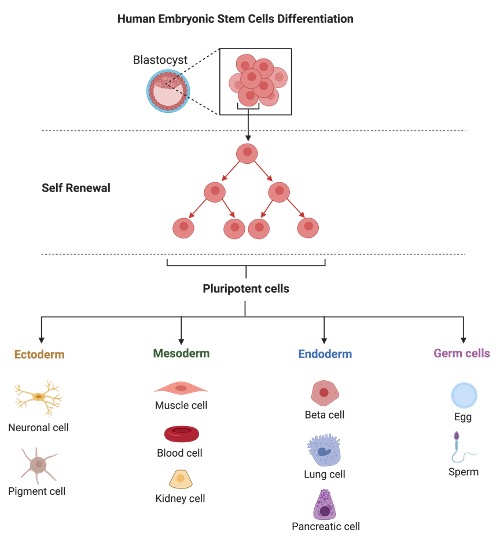Table of Contents
Embryonic Stem Cells Research
Embryonic stem cell research provides a wonderful method to cure a variety of diseases that have failed to respond to traditional therapies. With embryonic stem cells, a beneficial alternative method to treating injuries and some diseases may be given with relatively low risks.
What makes embryonic stem cells so intriguing?
Mitosis is a process that allows these cells to self-renew. They’re also pluripotent, which means they may develop into a more specialised, mature cell type that can perform multiple activities.

It implies that these cells, like a normal cell of a growing embryo within the mother’s uterus, can differentiate into any fundamental cell type — whether it a blood cell, muscle cell, nerve cell, or other — can give rise to diverse cell kinds. The distinction is that embryonic stem cells are generated, maintained, and developed outside of the human body in laboratory conditions.
What do these characteristics imply in terms of medicine?
Because embryonic stem cells have the ability to self-renew and display pluripotency, they can be utilised in regenerative medicine procedures like tissue grafts while reducing, if not eliminating, the danger of donor-host rejection and teratoma.
These cells can also be utilised to replace the body with functioning cells because they can transform into any of the basic adult cells. These cells can thus be given to individuals with tissue injuries or genetic abnormalities in order to repair damaged or defective cells.
They can also be used as models for genetic diseases since they can reproduce endlessly. As a result, they have the potential to become a powerful research tool for probing human genetic diseases, including fragile X syndrome and cystic fibrosis.
How can embryonic stem cells be immoral?
Embryonic stem cells are, first and foremost, cells with the ability to live. The “embryonic” component sparks a slew of arguments coming from a lack of agreement on the meaning, boundaries, and purpose of life. “When does life begin and end?” and “Does an embryonic stem cell implicate life or not?” are difficult to explain clearly.
Those who are against it think that these cells are likewise alive. Others, on the other hand, believe that embryonic stem cells do not represent life, but rather a potential for life. Another factor that relates to the above is the lack of agreement on how to classify humans.
Embryonic stem cells act in the same manner that normal embryonic cells do in the development of a human foetus. As a result, despite their in vitro origin, opponents might view embryonic stem cells as potential human beings. If this type of study continues, the essence of human existence may be polluted in the near future, especially from the perspective of religious and social organisations.
Finally, techniques involving the storage and destruction of embryonic stem cells for research are considered unethical. Storing embryonic stem cells appears to be a denial of the right to human life. The proponents, on the other hand, use the “nothing is lost” argument to justify their position.
They believe that because there is an excess of in vitro embryos, these embryos must be saved for future research purposes. What else can be done with these embryos is to put them to good use, such as in research that might lead to important discoveries that could save lives.
There is a surplus of 400,000 human embryos generated through in vitro fertilisation in the United States, which are frozen and maintained to this day. Nonetheless, pro-life groups continue to oppose the initiative since studies involving these embryos ultimately result in the killing of the embryo, labelling the technique “murder.”
Because of the ethical issues involved, embryonic stem cell research is a contentious topic. It just goes to demonstrate that what is generally good does not always imply that it is also ethically correct.
Nucleotide Citations
- Differentiation of embryonic stem cells to clinically relevant populations: lessons from embryonic development. Cell . 2008 Feb 22;132(4):661-80.
- Differentiation of human embryonic stem cells and induced pluripotent stem cells to cardiomyocytes: a methods overview. Circ Res . 2012 Jul 20;111(3):344-58.
- Human embryonic stem cells: derivation, culture, and differentiation: a review. Restor Neurol Neurosci . 2010;28(4):589-603.
- Embryonic stem cells. Stem Cells Dev . 2007 Apr;16(2):213-22.
- Figures are created with BioRender.com







